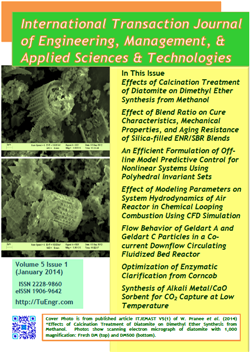International Transaction Journal
of Engineering, Management,&
Applied Sciences & Technologies
:: International Editorial Board:
|
Archives
Vol.5(1) (January 2014)


:: International Transaction Journal of Engineering, Management, & Applied Sciences & Technologies
http://TuEngr.com

 Cover V5(1) January 2014 Cover V5(1) January 2014
(mirror full issue @ SlideShare, Full issue @ Issuu, Full Issue Fast Web View, Quailty Web View)
ISSN 2228-9860
eISSN 1906-9642
FEATURE PEER-REVIEWED ARTICLES
|
Watcharakorn Pranee (Department of Chemical Engineering, Faculty of Engineering, Khon Kaen University, Khon Kaen 40002, THAILAND) Pornsawan Assawasaengrat (Department of Chemical Engineering, Faculty of Engineering, King Mongkut’s Institute of Technology Ladkrabang, Bangkok, 10520, THAILAND ) Arthit Neramittagapong, and Sutasinee Neramittagapong *( Department of Chemical Engineering, Faculty of Engineering, Khon Kaen University, Khon Kaen 40002, THAILAND)
|
(Optimized file)
DOI: 10.14456/itjemast.2014.1
Keywords: DME; renewable energy; methanol; acid catalyst.
Abstract
The synthesis of dimethyl ether via methanol dehydration over diatomite catalysts was investigated. The reactions were carried out in a fixed bed reactor. The effects of calcinations of diatomite on its catalytic performance were studied. Diatomite calcined at 500°C (DM500) gave the higher BET surface than fresh diatomite (DM) due to the loss of ignition. The rate of reaction over DM500 catalyst was lower than fresh DM due to the loss of active sites on the catalyst surface. However, the decrease of basicity of DM500 surface showed the higher selectivity to DME than fresh DM. The DM500 catalyst exhibits better DME yield than fresh DM catalyst, although it can be used as a selective catalyst for DME synthesis from methanol.
Chanin Ngudsuntear, Sunun Limtrakul, Terdthai Vatanatham (Department of Chemical Engineering, Kasetsart University, Bangkok, THAILAND) Adul Na Wichien (Rubber Research Institute of Thailand, Ministry of Agriculture, Chatuchak Bangkok,THAILAND ) Garry L. Rempel ( Department of Chemical Engineering, University of Waterloo, Ontario, CANADA) and Wanvimon Arayapranee * ( Department of Chemical and Material Engineering, Rangsit University Phathum Thani, THAILAND)
|
(Optimized file)
DOI: 10.14456/itjemast.2014.2
Keywords: Epoxidized natural rubber; Tensile properties; Oil resistance.
Abstract
The effects of blend ratio on cure characteristics, tensile properties and the resistance to oil and thermal aging of epoxidized natural rubber (ENR) blended with styrene butadiene rubber (SBR) was investigated in the presence of silica selected as a reinforcing filler due to its unique characteristic to interact with ENR. The composition of ENR and SBR was varied from 0 to 100%. The results indicate that the Mooney viscosity and cure time, tc90 decreased with an increase of ENR in the blends. The silica-filled ENR exhibited higher tensile properties and high crosslink density compared to silica-filled SBR. The oil and thermal aging resistance of the ENR/SBR blend were increased with increasing ENR content.
Pornchai Bumroongsri * (Department of Chemical Engineering Faculty of Engineering, Mahidol University, THAILAND) Pornpun Arundechachai, and Soorathep Kheawhom (Department of Chemical Engineering Faculty of Engineering, Chulalongkorn University, THAILAND )
|
(Optimized )
Keywords: control law; real-time interpolation; scheduling parameter; MPC algorithm.
Abstract
In this research, an efficient formulation of off-line model predictive control for nonlinear systems is presented. The nonlinear systems are reformulated as linear parameter varying systems so their complexity is reduced without any loss of generality. The on-line computational burdens are decreased by pre-computing off-line the sequences of explicit control laws corresponding to the sequences of polyhedral invariant sets. At each sampling time, the current state and the scheduling parameter are measured. The real-time control law is then calculated by linear interpolation between the pre-computed control laws. The results indicate that the proposed algorithm can achieve better control performance compared to the previously developed off-line robust model predictive control algorithm because the scheduling parameter is incorporated into the controller design.
Piriya Laiarpatorn, (Department of Chemical Technology, Faculty of Science, Chulalongkorn University, THAILAND) Pornpote Piumsomboon, and Benjapon Chalermsinsuwan * (Department of Chemical Technology, Faculty of Science, Chulalongkorn University, THAILAND and Center of Excellence on Petrochemical and Materials Technology, Chulalongkorn University, THAILAND)
|
(Optimized )
Keywords: DME; renewable energy; methanol; acid catalyst.
Abstract
The system hydrodynamics or flow behavior of gas and solid particles was simulated using computational fluid dynamic (CFD) model inside air reactor of chemical looping combustion (CLC). The two fluid model or Euler-Euler model was selected to use together with the kinetic theory of granular flow model (KGTF). In this study, the effect of modeling parameters including drag coefficient model, specularity coefficient and restitution coefficient between solid particles were explored. The EMMS drag model gave the highest solid volume fraction inside the system due to the particle cluster assumption in the model development. The specularity coefficient and restitution coefficient between solid particles had slightly effect on the results. In addition, the obtained results were compared with literature experiment by Shuai et al. (2012). The radial profiles of solid concentration from CFD simulation were consistent with the experimental data. The conventional core-annulus flow structure was still observed in the air reactor.
Parinya Khongprom, Piyanat Soontarose, Sirilux Manchandrarat (Department of Industrial Chemistry Faculty of Applied Science, King Mongkut’s University of Technology North Bangkok, THAILAND and Integrated Nanoscience Research Center, Science and Technology Research Institute, King Mongkut’s University of Technology North Bangkok, THAILAND ) Sunun Limtrakul, and Terdthai Vatanatham (Department of Chemical Engineering, Faculty of Engineer, Kasetsart University, THAILAND )
|
(Optimized )
Keywords: Geldart particle; Downer reactor; Simulation; CFD; Two-fluid model.
Abstract
The purpose of this research is to study the effect of Geldart A and C particles on the hydrodynamics behavior in a 9.3 m height, 0.1 m diameter co-current downflow circulating fluidized bed (downer reactor) using CFD simulation. Two-fluid model with kinetic theory of granular flow was adopted to predict flow behavior in the system. The simulation results show that hydrodynamics behavior in the downer strongly depends on the type of the particle. Geldart C particle exhibits a more uniform distribution along the lateral direction as compared with Geldart A particle. In addition, the effects of operating conditions were also studied. The uniformity of lateral direction of solids fraction increases with decreasing of solids circulation rate (Gs) or increasing of inlet superficial gas velocity (Ug). However, the radial distributions of gas and solids velocity are more uniform when Ug decreases especially for Geldart C particle.
SininartChongkhong *, and Woraluk Kongjindamunee (Department of Chemical Engineering Faculty of Engineering, Prince of Songkla University, THAILAND)
|
(Optimized )
Keywords: Alpha-amylase; Glucose content; Hydrolysis; Central composite design.
Abstract
A major content that was 22.76% total carbohydrate of the corncob could be simply hydrolyzed into reducing sugars by using alpha-amylase. The clarification process using alpha-amylase was optimized by response surface methodology (RSM) in this work. Independent variables including: enzyme amount of 0.05-0.2 %w, time of 60-240 min and temperatures of 80-100°C were investigated. Their effects were found on the reducing sugar (Glucose content) by a second order central composite design (CCD). The optimum condition was 0.2 %w alpha-amylase, 87.6°C for 150 min. It could provide the highest amount of 6.21 g/L glucose content in the clarified product.
Nusavadee Pojananukij, Nannaphas Runruksa , Sutasinee Neramittagapong a, and Arthit Neramittagapong * (Department of Chemical Engineering, Faculty of Engineering, Khon Kaen University, Khon Kaen, 40002, Thailand)
|
(Optimized )
Keywords: potassium carbonate; decarbonation process ; Thermogravimetric Analyser.
Abstract
In order to improve their CO2 absorption capacity at low temperature, alkali-based sorbents were prepared by impregnation method. It was found that supported CaO modified with a K/Ca molar ratio of 3 kept the most favorable stability and CO2 uptake capacity among the proposed K2CO3-stabilized samples. The result showed that the total CO2 capture capacity of 3K/CaO was 3.84 mg CO2 /g sorbent at 50°C. The X-ray diffraction (XRD) result revealed the new structure was formed during CO2 adsorption such as CaCO3 and K2Ca(CO3 )2.
.
Previous: Vol 4(4) October 2013 ......... Next: Vol 5(2) April 2014
Call-for-Papers
Call-for-Scientific Papers
Call-for-Research Papers: ITJEMAST invites you to submit high quality papers for full peer-review and possible publication in areas pertaining engineering, science, management and technology, especially interdisciplinary/cross-disciplinary/multidisciplinary subjects.
To publish your work in the next available issue, your manuscripts together with copyright transfer document signed by all authors can be submitted via email to Editor @ TuEngr.com (no space between). (please see all detail from Instructions for Authors)
Publication and peer-reviewed process:
After the peer-review process (4-10 weeks), articles will be on-line published in the available next issue. However, the International Transaction Journal of Engineering, Management, & Applied Sciences & Technologies cannot guarantee the exact publication time as the process may take longer time, subject to peer-review approval and adjustment of the submitted articles.
 |



 Cover V5(1) January 2014
Cover V5(1) January 2014





